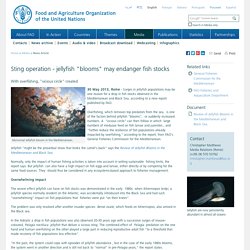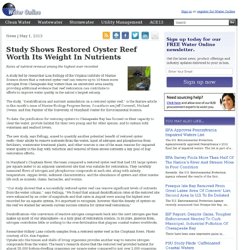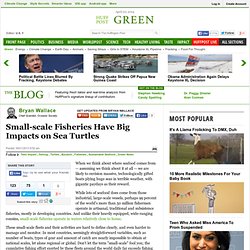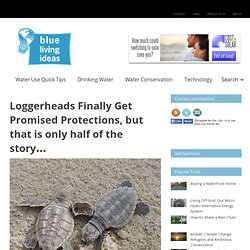

Media Centre: Sting operation - jellyfish "blooms" may endanger fish stocks. Abnormal Jellyfish bloom in the Mediterranean. 30 May 2013, Rome - Surges in jellyfish populations may be one reason for a drop in fish stocks observed in the Mediterranean and Black Sea, according to a new report published by FAO.

Overfishing, which removes top predators from the sea, is one of the factors behind jellyfish "blooms", or suddenly increased numbers. A "vicious circle" can then follow in which large numbers of medusae feed on fish larvae and juveniles , and "further reduce the resilience of fish populations already impacted by overfishing," according to the report, from FAO's General Fisheries Commission for the Mediterranean.
i3169e. The U.N. wants you to eat some jellyfish with those insects. On Thursday, the Food and Agriculture Organization (FAO) offered the citizens of the world a suggestion about how to counteract harmful jellyfish overpopulation, which has been exacerbated in recent years by factors such as overfishing and climate change.

"If you cannot fight them… eat them," the U.N. body offered in a report, citing past studies on the subject: Some jellyfish species are a food source in some countries (e.g. 328na3. H1N1 discovered in marine mammals. Public release date: 15-May-2013 [ Print | E-mail | Share ] [ Close Window ] Contact: Tracey Goldstein tgoldstein@ucdavis.edu 530-752-0412 University of California - Davis Scientists at the University of California, Davis, detected the H1N1 (2009) virus in free-ranging northern elephant seals off the central California coast a year after the human pandemic began, according to a study published today, May 15, in the journal PLOS ONE .

It is the first report of that flu strain in any marine mammal. "We thought we might find influenza viruses, which have been found before in marine mammals, but we did not expect to find pandemic H1N1," said lead author Tracey Goldstein, an associate professor with the UC Davis One Health Institute and Wildlife Health Center. UC Davis researchers have been studying flu viruses in wild birds and mammals since 2007 as part of the Centers of Excellence in Influenza Research and Surveillance program funded by National Institutes of Health. About UC Davis. Pandemic H1N1 Influenza Isolated from Free-Ranging Northern Elephant Seals in 2010 off the Central California Coast. Abstract Interspecies transmission of influenza A is an important factor in the evolution and ecology of influenza viruses.

Marine mammals are in contact with a number of influenza reservoirs, including aquatic birds and humans, and this may facilitate transmission among avian and mammalian hosts. Virus isolation, whole genome sequencing, and hemagluttination inhibition assay confirmed that exposure to pandemic H1N1 influenza virus occurred among free-ranging Northern Elephant Seals (Mirounga angustirostris) in 2010. Nasal swabs were collected from 42 adult female seals in April 2010, just after the animals had returned to the central California coast from their short post-breeding migration in the northeast Pacific. Ice melt, sea level rise, to be less severe than feared: study. Seas will rise no more than 69 centimetres by 2100 - environment - 14 May 2013. It's not as bad as we thought.

A comprehensive study of the behaviour of ice sheets suggests that their melting will add no more than 36.8 centimetres to sea levels by 2100. That means the total sea-level rise this century should be no more than 69 centimetres. Seas will rise as the world warms because warmer water expands and because glaciers and ice sheets will melt and slide into the ocean. However, we don't know how fast they will rise: predicting how much ice will be lost, and when, has proved very difficult. Now a large team of scientists called Ice2sea has completed the most thorough assessment yet. The team estimates that if carbon dioxide emissions continue to rise rapidly until 2100, melting and shifting ice sheets will add 3.5 to 36.8 cm to sea levels by 2100.
Adding in the effect of expanding seawater, Vaughan calculates that sea levels will rise by 16 to 69 cm by 2100. (IPCC) in 2007: it predicted 18 to 59 cm by 2100. Known unknowns. Earthquake sensors on seafloor track whale songs. U.

WASHINGTON (US) — Seafloor earthquake sensors are an inexpensive and noninvasive way to monitor the movements of fin whales that are vulnerable to collision with fast-moving ships. Fin whales are the second-largest animal ever to live on Earth—but paradoxically are also one of the least understood because their huge size and global range make movements and behavior hard to study. Oceanographers are using seafloor seismometers, devices that record vibrations, to better understand swimming behaviors that could help vessels avoid the “greyhounds of the sea.” Understanding where and what the animals eat could help support their slowly rebounding populations. A seismometer inserted into a hole drilled in seafloor lava. A series of studies in the Journal of the Acoustical Society of America are the first to match whale calls with fine-scale swimming behavior, providing new hints at the animals’ movement and communication patterns.
Source: University of Washington. Study Shows Restored Oyster Reef Worth Its Weight In Nutrients. Rates of nutrient removal among the highest ever recorded A study led by researcher Lisa Kellogg of the Virginia Institute of Marine Science shows that a restored oyster reef can remove up to 10 times more nitrogen from Chesapeake Bay waters than an unrestored area nearby, providing additional evidence that reef restoration can contribute to efforts to improve water quality in the nation’s largest estuary.

The study, “Denitrification and nutrient assimilation on a restored oyster reef,” is the feature article in this month’s issue of Marine Ecology Progress Series. Co-authors are Jeff Cornwell, Michael Owens, and Ken Paynter of the University of Maryland Center for Environmental Science. Plastics concentrate toxins. Long-term field measurement of sorption ... [Environ Sci Technol. 2013.
327na3rss. DNV and WWF partner to develop concept design for research vessel to focus on plastic debris in oceans. 'Sustainable fishing' certification too lenient and discretionary, study finds. The certification of seafood as "sustainable" by the nonprofit Marine Stewardship Council is too lenient and discretionary, a study by a consortium of researchers has found.

"When consumers want sustainable fish there are two options to meet the demand: fisheries can become more sustainable or the definition of sustainable can be watered down to be practically meaningless—with MSC seafood, the definition has been repeatedly watered down," said Jennifer Jacquet, a clinical assistant professor in New York University's Environmental Studies Program and one of 11 authors of the study, which appears in the journal Biological Conservation. The expansion of fishing in the oceans—further offshore, deeper, and for different species—has led to the depletion of many marine fish populations. Waitrose aspires to be first on sustainable fish. Marine Council's ‘Eco-Labeling’ Process Is Too Lenient, Report Says. Bryan Wallace: Small-scale Fisheries Have Big Impacts on Sea Turtles.
When we think about where seafood comes from -- assuming we think about it at all -- we are likely to envision massive, technologically gifted boats plying huge seas in terrible weather, with gigantic paydays as their reward.

While lots of seafood does come from those industrial, large-scale vessels, perhaps 99 percent of the world's more than 50 million fishermen operate in artisanal, traditional and subsistence fisheries, mostly in developing countries. And unlike their heavily equipped, wide-ranging cousins, small-scale fisheries operate in waters relatively close to home. These small-scale fleets and their activities are hard to define clearly, and even harder to manage and monitor. In most countries, seemingly straightforward variables, such as number of boats, types of gear and amount of catch are nearly impossible to obtain at national scales, let alone regional or global. Photo: Projeto Tamar Brasil -- Image Bank. Loggerheads Finally Get Promised Protections, but that is only half of the story… Marine Life Published on April 9th, 2013 | by Guest Contributor Sea turtles have been swimming the planet’s waters for millions of years, surviving everything from the mass dinosaur extinction to countless natural disasters and cunning predators.

In recent years however, sea turtle populations have begun to plummet as they’ve encountered the one threat they have no defenses against—us. Recently, however, there has been reason for sea turtle lovers to rejoice, as the U.S. Fish and Wildlife Service finally designated 740 miles of critical habitat for threatened loggerhead sea turtles along the East Coast and Gulf of Mexico shorelines. Although this designation is great news, it should have happened years ago.
Since their threatened listing in 1978, just five years after the Endangered Species Act was created, critical habitat has never been designated.